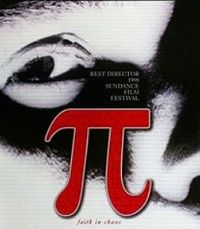Director Darren Aronofsky doesn’t underplay the paranoid aspect of his 1998 debut Pi: the tagline is "paranioa is faith in a hidden order beyond the visible" – a hook Vigilant Citizen eventually bit on. However, I think the film is a meditation on that classical allegory of painful awakening, The Cave in Plato’s Republic.
The protagonist, Max Cohen, says near both the start and finish of the film that despite his mother’s warning not to look into the sun he did so at the age of six and, after being initially blinded, "something…inside me had changed."
Plato prefaces the Cave with a passage about the sun (Max’s mentor is called Sol), to compare the visible world with the intellectual. The point about the Cave is the contrast between the visible world and reality. The film mirrors the allegory’s four parts:
- Prisoners observe "reality": artworks’ shadows cast by a fire behind them.
Max uses his obsession with numbers to play the stockmarket.- One of the prisoners is turned round and sees the fire.
Sol alerts max to the vital importance of the 216-digit number displayed by his computer before it crashes.- A prisoner is dragged to the surface to see the sun.
Max will learn from Jewish Kabbalists that the number represents God (before the Cave, Plato uses the sun to represent the Good).- Should the prisoner return, Plato surmises, his former associates will try to kill him.
Max was almost killed for his realisation that his number relates to a reality beyond that of the stockmarket.
The lesson I took from Pi is the one thinkers of all traditions tend to conclude: the world that brings us joy is the one we walk upon and share with others, but awakening to that world, forever in front of our noses, involves a long and painful journey.
Gerry Dorrian
300 words
Resources
""something…inside me had changed" quote from Pi IMDb
The Republic - Plato, Electronic Classics. The allegories of the sun, the divided line and the cave are from p187 (starting with the section marked Glaucon-Socrates) to p196.
Sun, Divided Line and Cave - J.E. Raven, Cambridge University Press (Jstor/The Classical Quarterly, 1952): an academic article that might be of help in understanding the allegories.

No comments:
Post a Comment